


The dataset presented here is composed of:ġ51 pictures of both ovaries for the 151 fish sampled during this study Ģ26 histological slides scanned, with 151 median ventral (V2) ovarian sections and an additional 75 ovarian sections from the anterior ventral (V1), posterior ventral (V3), anterior dorsal (D1), median dorsal (D2), and posterior dorsal (D3) positions ĭata frames with the reading results for the 226 histological slides ĭata frame with the general data and macroscopic measurements for all 151 fish. Each slides were then scanned and stereology was used to quantify each structure found throughout the ovary. 1), each plaice was measured (weight and size), their otoliths were collected for age estimations and the ovaries were extracted to be photographed, weighed, put into a Davidson solution before being cast into paraffin, trichrome stained (Prenant-Gabe 14), and mounted between slide and slip.
#Stereology counting rules update
Pleuronectes platessa was chosen as an easy to access and important commercial fish species, with the aim to update the outdated knowledge on the histological structures of this species’ ovaries 10, 11, 12, 13.ĭuring this study (Fig. Moreover, in order to harmonize data collection and terminologies, the terminology used by Brown-Peterson and al 4, and the maturity scale of the ICES 5, 9, were used. This project aimed to bring knowledge on the ovarian histology of the North Sea plaice ( Pleuronectes platessa) in order to correlate histological maturity with macroscopic parameters like the size, weight and age of the fish, as well as the size, color and texture of the ovaries. This study has been set under project MATO (“MATurité Objective des poissons par l’histologie quantitative” - Objective fish maturity using quantitative histology), carried out by the Institut Français de Recherche pour l’Exploitation de la Mer (IFREMER).

This led the International Council for the Exploration of the Sea (ICES) to work on harmonizing the definitions, terminologies and practices used to determine these different maturity phases 9. Moreover, the maturity cycle of certain fish species is poorly known 6, the determination of maturity phases can show great variability between assessing operators 7, 8, there are numerous terminologies to describe the ichthyological reproductive system 4, 5, 9, and maturity scales are in constant evolution and differ from one institution to another 5. Unfortunately, these methods are very subjective, with the use of criteria such as the size, color or texture of the gonads, to estimate sexual maturity of commercial species 4, 5. Being able to accurately determine the maturity phase of a fish is thus of paramount importance 1, 3. This reproductive capacity, or the capacity of a fish population to produce viable eggs and larvaes 1, is usually estimated through the computation of the fish length at which 50% of the fish population has reached sexual maturity (L50) 2. In stock assessments, the reproductive capacity of a commercial fish species is a key parameter for fisheries management plan.
#Stereology counting rules full
This dataset can be used to automate the stereological reading process (through statistical learning methods for example) or to objectively determine the plaice’s maturity phase, and link that information to either macroscopic measurements or through image analysis of the full ovaries. The distribution and homogeneity of the different cell types found throughout the ovaries were also evaluated. Inter-agent calibrations were accomplished in order to harmonize the stereological readings, and were based on a comprehensive reading protocol and histological lexicon that were specifically written for the plaice’s ovaries. Stereology was used to determine the percentage of different structures found throughout the ovaries. The following dataset is a collection of female plaice gonad images and their corresponding histological slides, collected during a complete season of the plaice’s reproduction cycle. The North Sea plaice, Pleuronectes platessa (Linnaeus, 1758), is a commonly studied commercial flatfish with poorly known ovarian histology.


 0 kommentar(er)
0 kommentar(er)
